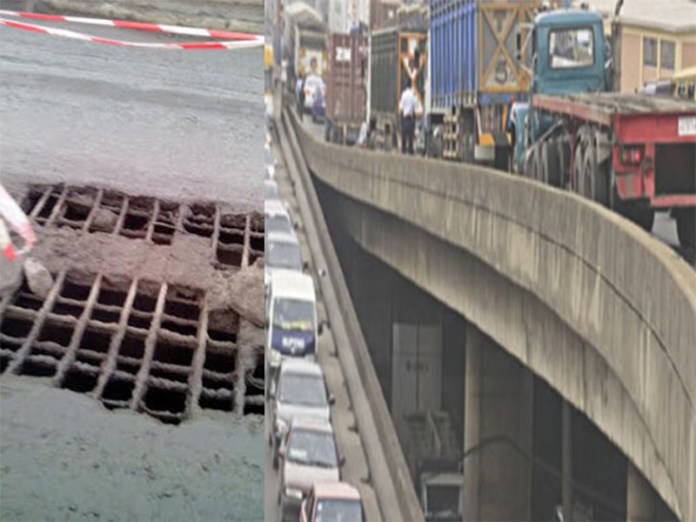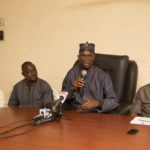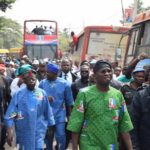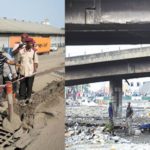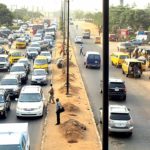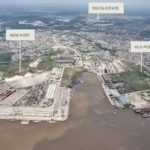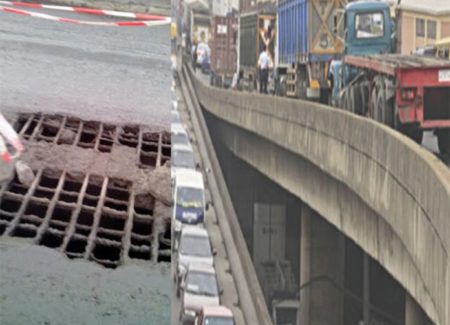
The Federal and Lagos State Governments Friday disclosed plan to save Marine Beach Bridge (Apapa-Ijora Bridge), which connects Apapa Central Business District (CBD) to Lagos Island and Lagos-Ibadan expressway via Ikorodu road.
Before they unveiled the new intervention, a portion of the bridge had caved in, thus putting its structural integrity to question and causing intractable gridlocks that often paralysed businesses in Apapa CBD.
But in a statement by the state’s Commissioner for Transportation, Dr. Ekundayo Mobereola, the federal government had directed that repair works should commence on the bridge, whose present conditions pose threat to national economy, lives and properties.
Consequently, the statement said the bridge, whose construction started under the regime of former Head of State, Gen. Yakubu Gowon and completed under the regime of Gen. Olusegun Obasanjo, would be closed to allow the Federal Ministry of Works, Power & Housing carry out studies on the bridge.
The statement explained the essence of the studies, which it said, was to determine the state of the Bridge and effect appropriate repairs, though detail about when the bridge would be closed was yet to be released.
The statement added that the emergency and immediate closure “is to also allow the federal ministry of power, works and housing carryout studies to determine the state of the Bridge and effect appropriate repairs.
“While the federal ministry of power, works and housing has assured of immediate action towards repairing the Bridge as it may deem fit, the Lagos State Government is committed to putting in place effective traffic management strategies that will mitigate the impact of the closure.”
The statement listed alternate routes for the use of commuters. It advised motorists coming from Wharf Base/Point Road “to divert at service Lane (Marine Beach Road) by Leventis Junction to Link Lilly Pond by Dockyard and ascend Ijora Bridge to continue their journey.”
It equally advised motorists traveling to Ajegunle “to take a left turn at the second junction under the Apapa Road Bridge to Marine Beach Junction inward Ajegunle or back to Ijora Bridge and continue their journey.
However, the statement said the traffic advice “is not to be used by heavy duty vehicles,” thereby imploring National Union of Petroleum and Gas Workers (NUPENG) and its members to observe the reroute especially so as not to block the road when accessing the tank farms at Lilly Pond.
The statement added that the state government “has among other initiatives deployed various signages directing traffic appropriately. It is equally important to ask motorist to please obey personnel of the Lagos State Traffic Management Authority (LASTMA), Federal Road Safety Corps (FRSC), Nigeria Police and other Law Enforcement Agencies deployed to control and manage traffic in the area.”
The prevailing condition of the bridge and its land area showed the failure of the federal government to implement the recommendation of a technical committee it set up with the Lagos State Government in 2012 to end diverse challenges threatening lives and businesses in Apapa CBD.
The committee, which was co-chaired by the Deputy Governor, Mrs. Adejoke Orelope-Adefilure and the Minister of Finance, Dr. Ngozi Okonjo-Iweala, came up with 12 recommendations directed at resolving diverse challenges of traffic gridlocks, environmental abuse and insecurity in Apapa.
The committee, among others, identified the need to rehabilitate bridges and roads, bio-remediate the degraded areas, rehabilitate abandoned trailer parks, dualise Wharf, Creek and Tincan roads, procure monitoring and heavy duty equipment, landscape and beautify open areas in Apapa CBD.
Apart from the dualisation of Wharf, Creek and Tincan roads, the committee put the total cost of Apapa regeneration plan at N11.60 billion, which it said, would be borne by the federal and state government.
The committee noted that the federal government would be responsible for 100 percent of the capital expenditures; 50 per cent of recurrent expenditure and the state government only for 50 per cent of the recurrent expenditure, meaning that the former would bear 75 per cent of the total cost and the latter 25 per cent.
As contained in the 64-page report, the committee earmarked N100.45 million for rehabilitation of Kirikiri trailer park; N114.40 million for rehabilitation of drainages and culverts and N6.49 billion for Rehabilitation of roads (Creek, Wharf and Commercial) and Marine Beach service lane.
It, also, earmarked N56.50 million for bioremediation of degraded areas; N1.42 billion for public lighting solution; N2.11 billion for landscaping and beautification; N97 million for initial cost of clearing; N585.25 million for procurement of monitoring & heavy duty vehicles; N466.91 million for security personnel; N33.24 million for sanitisation of cleared areas and N108.95 million for wire mesh fencing.
The committee said: “It is proposed that the Federal Government will be responsible (100 percent) for the initial capital expenditure and 50 per cent of the recurrent yearly, while the state government pays 50 per cent of the recurrent expenditure yearly. If approved, it means that the federal government will bear 75 percent of the initial cost outlay, while the state bears 25 percent.”
The committee noted that the state government bore the initial cost of N97 million, which it said, was spent to clear criminal hideouts; dismantle shanties and unlock traffic gridlocks in April 2012.
The committee noted that the state government would bear 25 percent of N694.20 billion meant for the erection of fence, procurement of heavy duty equipment and other logistics and N38.90 million for monthly sustenance, which it put at N466.90 million for a period of 12 months period.
However, THISDAY investigation revealed that the technical committee properly sent its report to the National Economic Council (NEC) in the second quarters of the 2012 fiscal year for all other necessary decision.
Since the report had been sent to the NEC in June 2012, the federal government had been silent about the report, which clearly identified areas of intervention by the two levels of government.
THISDAY gathered that the failure of the council adopt and implement the recommendations of the technical committee aggravated the menace of traffic gridlocks, environmental abuse and insecurity in Apapa and in its environs.
Source: Thisdaylive.com

